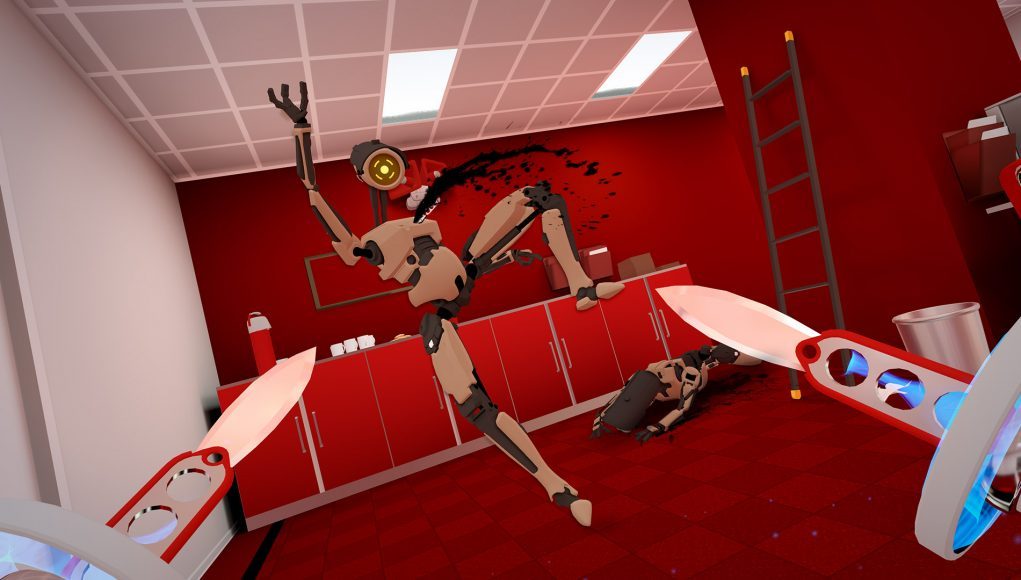Budget Cuts, a first-person stealth VR game, has been eagerly awaited since Stockholm-based indie studio Neat Corporation first released a free demo in 2016. The demo, which quickly became a breakout success in the early days of consumer VR, demonstrated a unique portal-teleportation mechanic, that, when married with the ability to throw knives at robot guards, spelled an instant hit—at least from a basic gameplay perspective. Two years later, the full release of Budget Cuts is here and it’s definitely been worth the wait.
Budget Cuts Details:
Developer: Neat Corportation
Available On: Steam (HTC Vive, Oculus Rift), Oculus Store (Rift)
Reviewed On: HTC Vive, Tested on Oculus Rift
Release Date: June 14th, 2018
Update (6/14/18): Following an indefinite delay announced one day before the game’s original May 31st launch date, Budget Cuts officially launches today (June 14th) at 10 AM PT (your timezone here). The delay was related to performance issues that some had reported during the game’s pre-release review build. However, we didn’t experience any major issues ourselves, and had published our initial review prior to the last minute delay announcement. As our team is at E3 2018 this week in Los Angeles, we haven’t had a chance to compare the pre-release review build to the release build, though the developer says performance has been improved on lower end systems. As soon as we’re back with VR headsets in hand, we’ll dig into the release build and update this review if there’s any noteworthy differences in our experience. That said, the review as presently printed represents the game’s pre-release review build as originally provided to us.
Gameplay
Cubicles, fluorescent lighting, copy machines that don’t work: offices can be a depressing place, but what’s even more depressing is when you find yourself in a boring, cookie-cutter job that’s slowly being automated away. But like Neo’s impetus to escape The Matrix, you soon find yourself receiving a strange phone call telling you to get the hell out of there, lest you wish to meet the same fate as your other human colleagues: reported to Human Resources to never be seen, or heard from again.
The Morpheus to your Matrix is Winta, a helpful voice on the other end of the fax machine who sends you instructions, clues, and guides you along your way as you uncover the truth behind the megalomaniac Texan owner ‘Rex’ and his obsession with squeezing the most out of his business. Humans, I learn, simply aren’t apart of the equation anymore, as an army of docile drones fill the workplace with canned banter like “You don’t have to be crazy to work here, but it helps!” and “Don’t you just hate Mondays?”
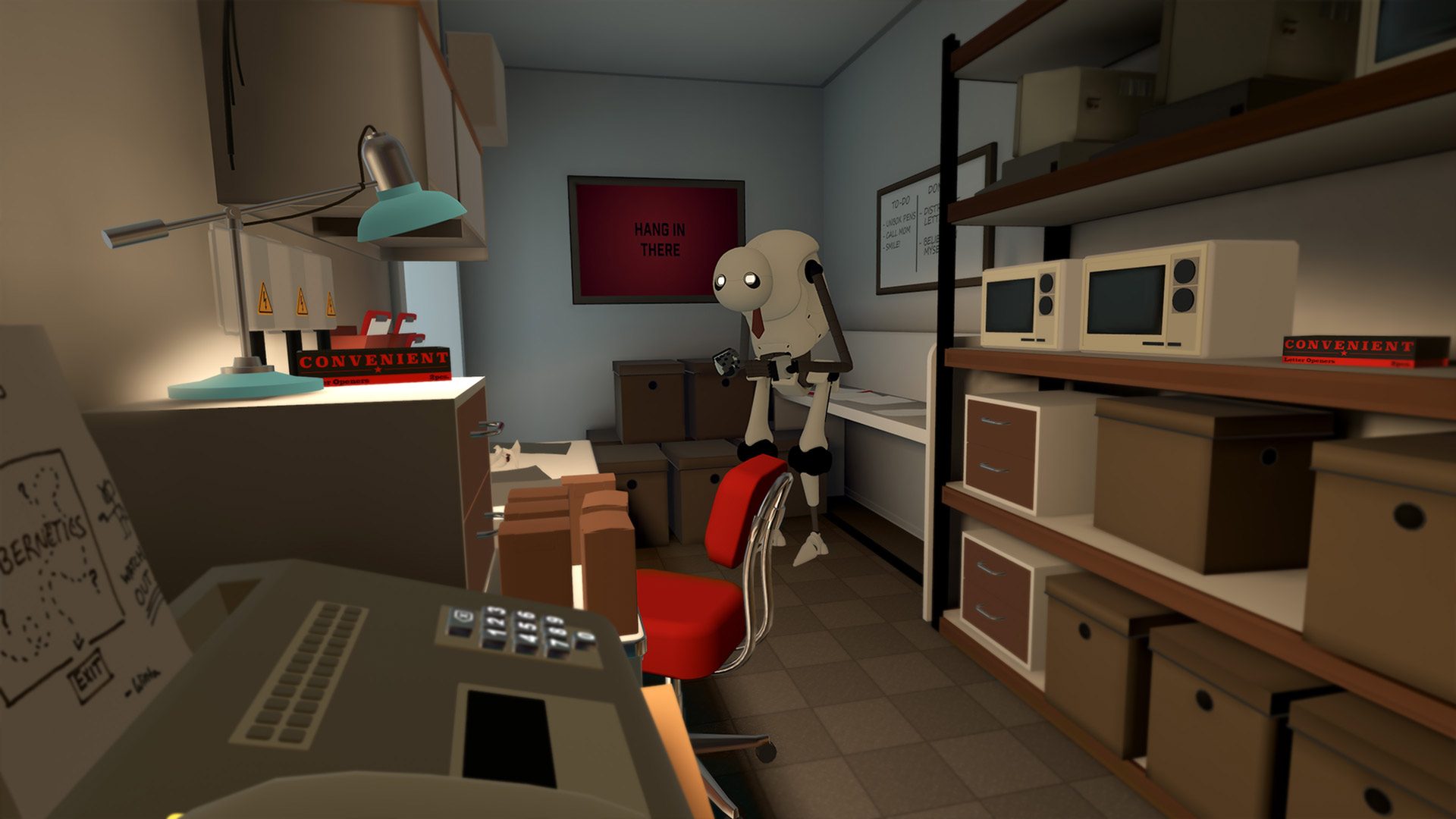
These aren’t the droids you’re worried about (or looking for), because in Rex’s palpable paranoia, which is constantly broadcasted over the office-wide loudspeaker, he’s peppered the office with military-grade security bots that tote revolvers, along with a keen sense of awareness when you’re in their line of sight. Thankfully, Winta has provided you with a number of “letter openers” (read: sharp throwing knives) and a translocator gun that lets you teleport around the sprawling office space like Nightcrawler, popping in and out of existence as you navigate the giant building’s many corridors and ventilation shafts. A preview portal lets you check if the coast is clear before committing to the jump, but the portal can be seen by anyone who looks your way.
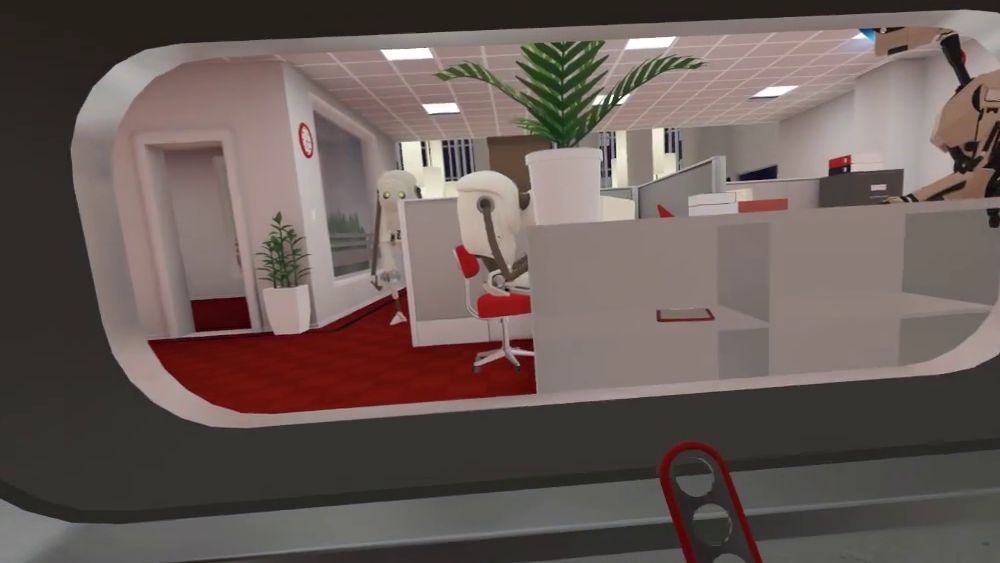
Other tools at your disposal: two gripping devices that take the place of your hands, and a magnifying glass-shaped viewer that lets you read the most essential bits of Winta’s messages, a nice touch to simplify the hand-written faxes, but not vital to the task at hand.
A quick pause before I get into the meat of the review. I have to say this: I loved the original Budget Cuts demo, and only wanted more of it, narrative be damned. But even then, Neat Corp has proven that it has storytelling chops too. I found myself exploring the facility, rifling through notes and learning about my colleagues that have disappeared before me, and laughing at the whole game’s quirky humor and tactful voiceovers. I didn’t need a fun and engaging story to enjoy ganking bots with my less-than-expert knife throws, but after playing, I can say this: expect more of Budget Cuts down the line, because there’s a big story to be told here, and I think I only scratched the surface in my nine hours of total gameplay. Now, back to the meaty bits:
I’m not ashamed to admit that in the beginning I had some trouble getting used to the way you change tools and access inventory, which hold five items of your choosing. While it took a little time to gain the muscle-button memory, Budget Cuts makes it clear that this isn’t a fast-paced, run-and-gun attack. You aren’t given an overly easy way to move and dispatch enemies because Budget Cuts is hard—and satisfyingly so.
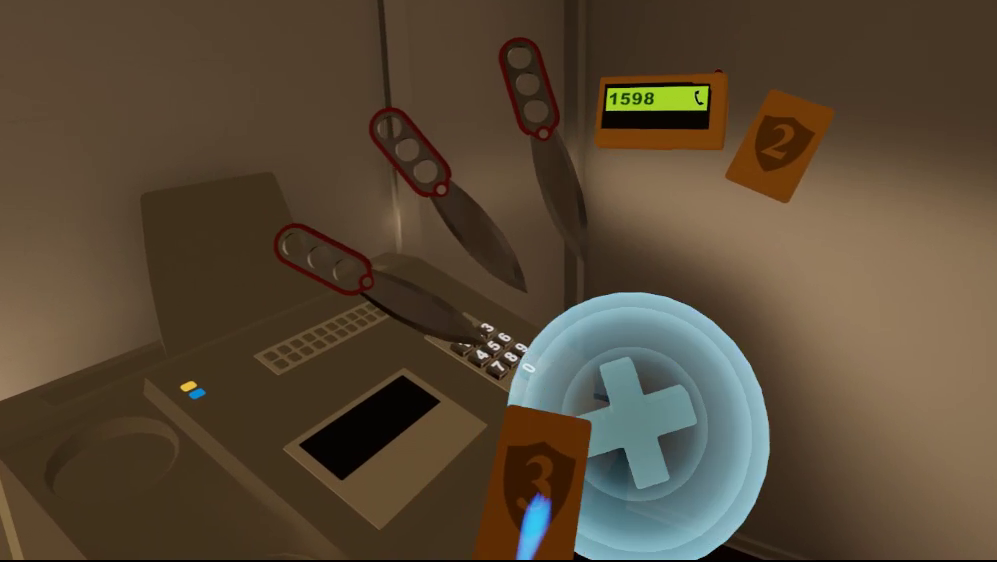
If you find yourself wishing for a silenced pistol, then you’re not playing the game right. There are no power-ups, no health boosts, no shields, and a single shot from a robot will send you back to your automatic save point. After multiple fails on a single level, it became clear to me that patience is more than virtue in Budget Cuts, it’s a necessity.
The game takes every violent situation, and makes it into a big moving puzzle; robots have standard patrol paths, and they usually stand between you and your objective; get a key card, door code, collect an item important to the narrative. Once you figure out the patrol path, you can swoop in and administer your three inches of steel, or you can challenge yourself by playing all the way through as a pacifist. That’s right, from head-to-toe, you can enforce your own Hindu code on Budget Cuts and complete the game without ever decommissioning a single robot. Ventilation shafts are plentiful, and only the quickest and most proficient teleporters can make it out alive.
The preview portal, which lets you look around corners before actually teleporting, presents its own dangers, as robots can see and shoot you through it. It’s an essential tool for figuring out where to go, and where your enemies are.

Level design is typically multilayered, offering a number of ways to complete an objective, be it a through the three foot-tall ventilation shafts, or by ducking for cover behind the many cubicles. Neat Corp has also made it near impossible to cheat by limiting your view when you either teleport, or pop your head through doors or walls. The anti-cheat system forces you to adapt to the game’s environment, making you duck in ventilation shafts, and bend down to peer through grates. I’ll cover more of that in the Immersion section, but suffice it to say that I loved how the game forces you to be present, and not take the easy way out.
Core game mechanics aside, what remains is really more than the sum of its parts. Adrenaline rushes of a missed knife throw (causing the target to spin around and point a gun in your direction), the act of sneaking around and planning your next move, following breadcrumb trails to a missing key—it all works so well together, making Budget Cuts one of the smartest VR games to date.
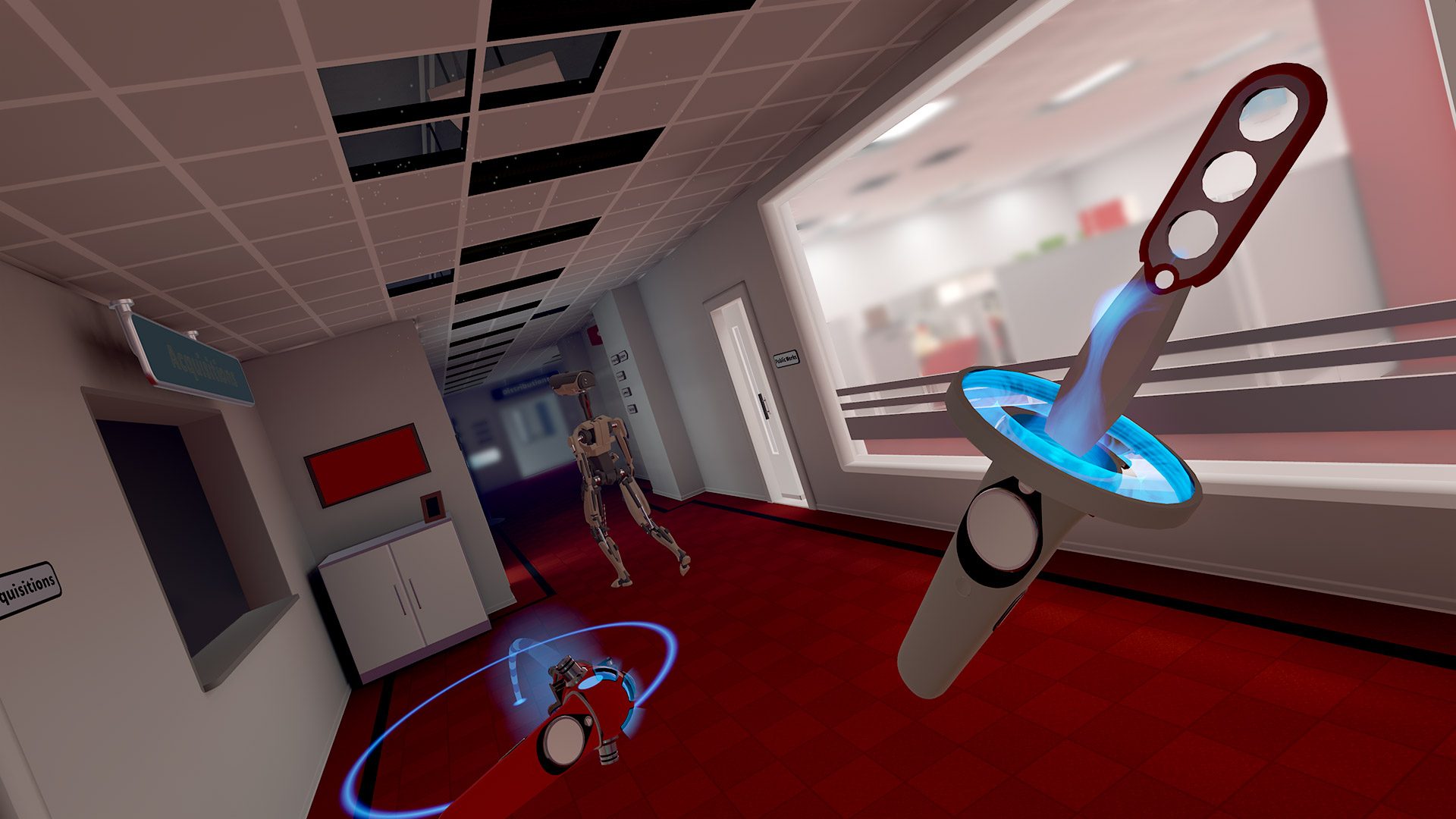
That said, I did experience some frustration with a few puzzles. If you have a hard time listening to instructions, Winta can’t help you, and she isn’t piped into your ear at all times—a good thing in my opinion.
Sometimes learning a new game mechanic, like unscrewing a grate with a screwdriver, can leave some logical gaps that may drive you crazy looking for the right solution. Fine attention to detail is a must with Budget Cuts, because once the office is splattered with robot blood and you’re still looking for that final key code, only your wits will save you.
Immersion
Budget Cuts is cartoony, but graphics aren’t really the most important thing when it comes to immersion. When everything works correctly, and there’s a sense of danger lurking around every corner, then you may find yourself cowering under a virtual desk for cover. You wouldn’t hide, or scream, or fumble through your inventory if you didn’t think you were in real danger.
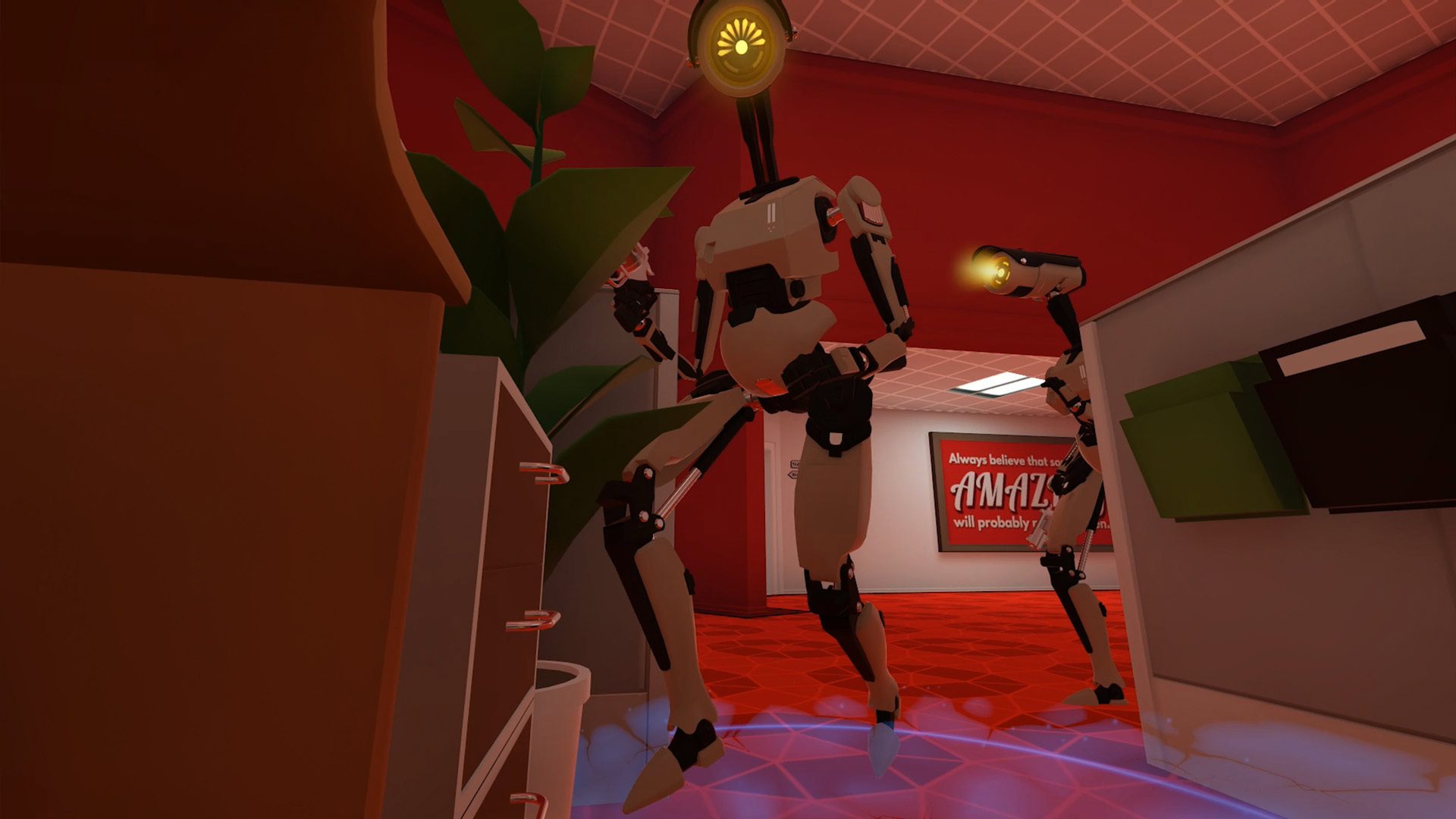
Therein lies the problem with the current generation of PC VR. Budget Cuts is a fiercely room-scale game that requires you to duck, take cover, and crawl your way through the world. This is great when you don’t have to mind the ever-present cable attached to your computer, which can take you out of the experience somewhat.
As a teleportation-only game though, I thought I would feel less immersed, but teleportation works extremely well given the game’s premise and objectives. For the anti-teleportation crowd: this game needs it, and gives you a good reason to use it.
Now for the bad: level loading times may be enough for you to hate taking a bullet, because you’ll sit around at a loading screen for about 20-30 seconds upon restart, and even more at the beginning of a new level.
Optimization is also a pain point. On Vive, I saw max performance, which had brief moments of jitter in more object-dense areas; not unplayable in the slightest, but less than I would have expected. For whatever reason, Rift optimization was worse, leading to brief moments of visible stuttering. For reference, my test rig has an Intel Core i7-6700K, 16 GB of RAM and a GTX 1080. I would have liked some degree of control over the graphical quality of the game, as there are no graphics options at all.
Some other less than impressive bits: textures sometimes popped in an out, some areas loaded slowly, and robots sometimes collided with the game’s geometry to comical effect after death. None of this is game breaking, but I worry the lack of user-controlled graphic options may make Budget Cuts even more jittery on lower-spec systems, provided there aren’t any behind-the-scenes automatic graphic optimizations tailored to your specific setup. I admittedly had a pre-launch press build, which came along with two caveats. 1) the version lacked 180-degree snap-turning for front-facing sensor setups (but will come in the launch version), only offering 360-degree sensor support. 2) And the press build was “bound to have bugs that we won’t see in the release build,” I was told. That said, I suspect the problem with Rift optimization will be solved at launch, or at very least in the first updates.
Comfort
Teleportation is by far the most comfortable of artificial locomotion schemes, making Budget Cuts among the most comfortable games to play for all levels. Room-scale locomotion, like peeking around corners and hiding behind barriers, is basically the most natural way to make minor adjustments. Once implemented, snap-turning for 180-degree sensor setups comes as a close second in terms of user comfort.
It’s also a very physical game too, ideally requiring the full use of your arms and legs. Crouching down to avoid detection and hobbling through ventilation ducts means you’ll be getting a quad workout to boot. Although if you are unable or unwilling to stand, much of the game’s objects are reachable from the height of a chair, so while there isn’t a bespoke ‘seated mode’, users shouldn’t have a problem playing seated, provided they’re well away from desks (or wayward children), and either use the 180 snap-turn, or have a spinning computer chair. Seated players may also have to play more tactically, since crouching around peeking around corners while seated isn’t as easy.

